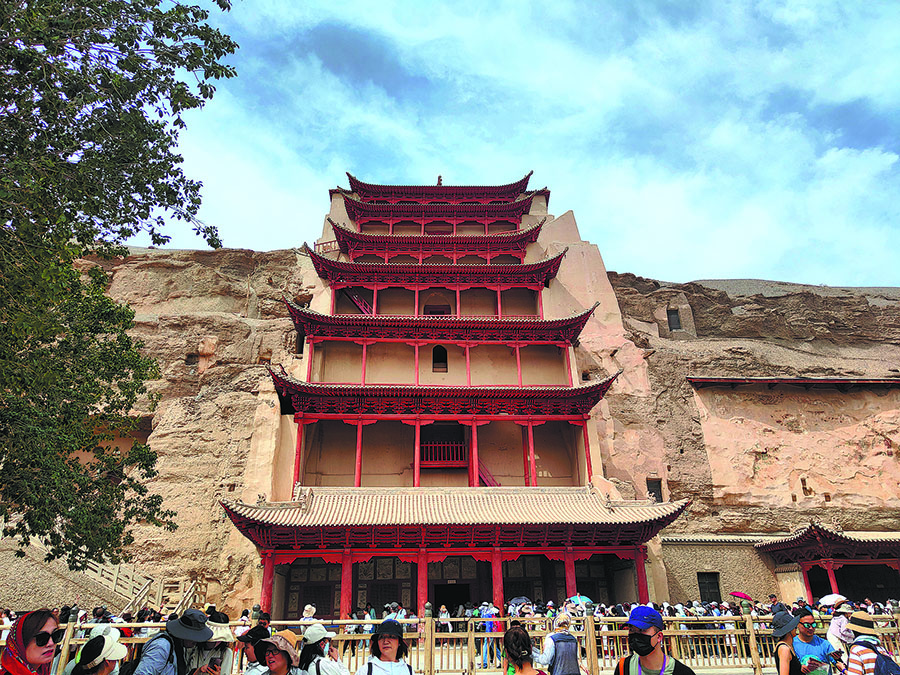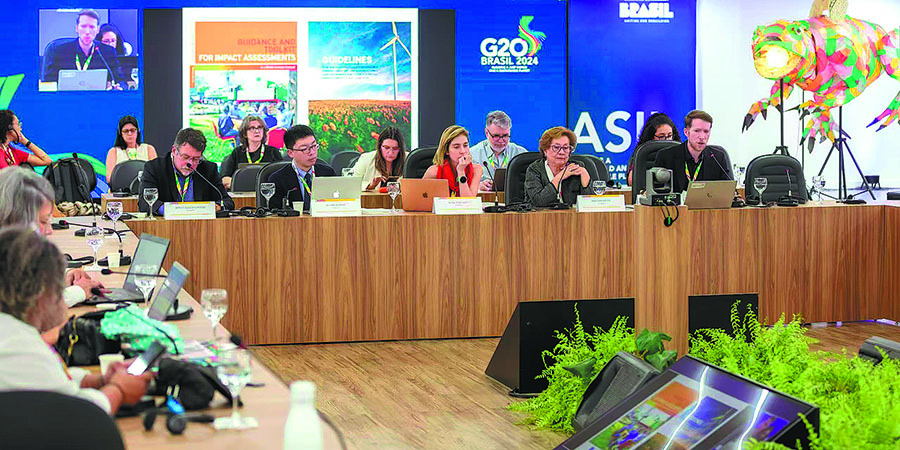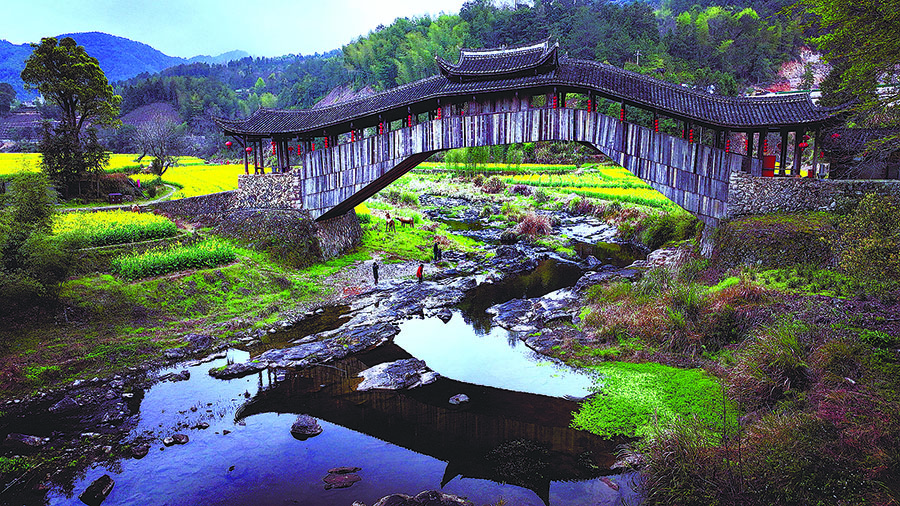Weatherproofing the past protects legacy
From:China DailyAuthor: 2024-12-02 09:48

Dunhuang in Gansu province provides a good example of how to protect cultural heritage in the face of extreme weather. [PHOTO BY WANG RU/CHINA DAILY]
Swift restorations of historical sites win global plaudits for setting example in overcoming climate change, Wang Ru reports.
After super typhoon Meranti almost washed away the historical bridges in Taishun county, Zhejiang province, in 2016, the community swiftly restored them using the original components and traditional construction techniques.
"The restoration proceeded through traditional ways, showcasing the age-old wisdom and tenacity of our cultural heritage. Also, local people managed to find the wooden components that had been washed away in the river. Thus, the bridges were not rebuilt but restored," says Yan Haiming, a researcher at the China Academy of Cultural Heritage.
Most of the components were recovered in less than two weeks, and the entire restoration project of the Xuezhai, Wenxing and Wenzhong bridges was completed about a year after the typhoon.
"Against the backdrop of extreme weather, it is important to act fast," says Yan.
"The restoration was completed in a timely manner, with the involvement of the government, experts and the community."
Yan shared this story as an example of China's response to extreme weather during a side event titled "Cultural Heritage and Climate Action" at the G20 Culture Working Group meeting held in Brasilia in May. The meeting served as a prelude to the 19th G20 Leaders' Summit in Rio de Janeiro, Brazil, on Nov 18 and 19.

Wenxing Bridge in Taishun county, Zhejiang province, is restored after a typhoon.[Photo provided to China Daily]
Growing attention
Combating climate change is a major issue, Yan says. In recent years, scholars put cultural heritage protection at the forefront, stressing a pressing need for swift measures in safeguarding it.
In 2021, UNESCO, the International Council on Monuments and Sites and the Intergovernmental Panel on Climate Change jointly held the International Co-sponsored Meeting on Culture, Heritage and Climate Change, the first high-level global academic discussion on this theme.
During the event, Liu Hongtao from Southwest Jiaotong University shared China's dedication to the protection of World Heritage sites against climate change.
During the G20 side event, Yan introduced China's practices for managing cultural heritage sites in response to extreme weather.
He emphasizes that adaptation and mitigation are two vital concepts widely accepted by the international academic community.
"Adaptation means that when the trend of climate change is believed to be irreversible, we need to adjust and find new ways of living and existing. Mitigation, on the other hand, is a more long-term and idealistic approach, focused on reducing greenhouse gas emissions or developing new technologies and energy sources to try to reverse the trend," says Yan.
During the event, Leandro Grass, president of Brazil's national historical and artistic heritage institute, opened discussions highlighting how climate change is being felt across the country.
"Brazil has much to offer in this discussion. Climate change needs to be properly addressed with public policies and concrete actions for life and sustainability," he says.

A G20 side event on cultural heritage and climate action is held in Brasilia in May.[Photo provided to China Daily]
The plight of indigenous people is a priority for Brazil, according to the country's delegates. Native communities are the most affected and vulnerable to climate change.
The Brazilian experts emphasize indigenous communities are in many ways living heritage, possessing intrinsic value in their unique way of life, and their wisdom should play a greater role in combating climate change.
Yan is also impressed by Spanish representative Antonio Antequera's introduction of a green paper on the sustainable management of cultural heritage.
He says the book provides fresh insight and combines academic studies, policy explanation and scientific popularization.
According to Yan, while many other countries' examples were concepts, China has done a lot to actually adapt, and its efforts have been pragmatic.
The restoration of Taishun arched bridges is a prime example of China's reaction mechanism in the face of extreme weather.
The country has also introduced preventive measures to predict the arrival of extreme weather and take action in advance.
For example, the Dunhuang Academy, which oversees the Mogao Caves, a UNESCO World Heritage Site in Dunhuang, Gansu province, has carried out studies on climate influence on the caves and murals over extended periods of time.
Yan says that the academy has collected and analyzed data on the impact of climate and environmental factors on caves and murals. This research enables scholars to understand the correlation between climate and conservation, and to implement targeted measures, such as building protective facilities, conducting regular maintenance and controlling the number of tourists.
But Dunhuang faces new problems in recent years.
In the past, it was a dry area where sandstorms were the major concern. But recently, the arrival of once-rare rainstorms poses new challenges, Yan says.

Wenxing Bridge in Taishun county, Zhejiang province, is restored after a typhoon.[Photo provided to China Daily]
Monitoring system
Chinese government attaches great importance to the protection of relics in extreme weather. Every year before flood season, the National Cultural Heritage Administration issues notices on strengthening the safety of cultural heritage, and then provinces, cities and lower administrative units react, forming a comprehensive system to prepare for natural challenges, says Yan.
In 2012, the China World Cultural Heritage Monitoring Center was established. Affiliated to the China Academy of Cultural Heritage, it is responsible for monitoring World Cultural Heritage sites in China. The indexes related to the natural environment and climate change are key factors in monitoring.
"China's heritage monitoring not only systematically categorizes types of disasters but also, based on data, summarizes the timing of extreme weather events and potential disaster occurrences each year, providing a basis for heritage managers to prepare for and prevent disasters," says Yan.
Foreign experts spoke highly of China's efforts. Andrew Potts, a specialist in this area from the United States, told Yan he hopes Chinese experts can take part in more discussions and contribute to a charter that will be issued during the 30th session of the Conference of the Parties to the United Nations Framework Convention on Climate Change (COP30) in Brazil next year.
Yan says China has rich experience in this area with many cases.
"We can attend more conferences of this type to spread our experience and enhance communication with our foreign counterparts," says Yan.
Edit:孙俪洋
The copyright of the article and the picture belongs to the original author. If there is any infringement, please contact to delete it